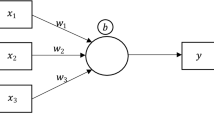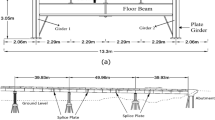Abstract
Background
Failure of the structure may be avoided if, the damage is noticed at an early stage and proper remedial work is performed. In this context, this paper presents a detection of structural damage in steel beams, which are major load carrying members in bridges and buildings.
Method
In the present study, the Generalized Flexibility Energy Quotient Difference Index (χ) is determined at various locations of the beam by introducing the damage by means of a cut by 0.5 mm to 2.5 mm at an interval of 0.25 mm. In practice, it is very difficult to capture all the modes of vibration. Hence, the method followed uses the first mode of vibration only for quantifying the magnitude of damage and its location. The validation is done between numerical simulations and experimental works for the estimation of first frequency. The efficiency of the method is tested by inducing the damage very close to the support. In ANN, the depth of cut at various locations of the beam and χ is utilized in the input layer.
Results
The predicted depth of cut or severity of damage from the output layer of ANN model is compared with the actual depth of cut induced in the beam. Finally, the polynomial equations are formulated for the damaged elements, which are the major contribution of the present study. These equations can be used as a ready reckoner to estimate the actual depth of cut in the beam. This approach is validated through a beam with fixed ends and two-span beam, and the results indicate that this method is very much beneficial in preventing the structural failure.

















Similar content being viewed by others
References
Nick H, Aziminejad A, Hosseini MH, Laknejadi K (2021) Damage identification in steel girder bridges using modal strain energy-based damage index method and artificial neural network. Eng Fail Anal 119:105010. https://doi.org/10.1016/j.engfailanal.2020.105010
Sadeghi F, Yang Y, Zhu X, Li J (2021) Damage identification of steel-concrete composite beams based on modal strain energy changes through general regression neural network. Eng Struct 244:112824. https://doi.org/10.1016/j.engstruct.2021.112824
Liu H, Song G, Jiao Y, Zhang P, Wang X (2014) Damage identification of bridge based on modal flexibility and neural network improved by particle swarm optimization. Math probl Eng 2014:640925. https://doi.org/10.1155/2014/640925
Tran-Ngoc H, Khatir S, De Roeck G, Bui-Tien T, WahabM A (2019) An efficient artificial neural network for damage detection in bridges and beam-like structures by improving training parameters using cuckoo search algorithm. Eng Struct 199:109637. https://doi.org/10.1016/j.engstruct.2019.109637
Kao CY, Hung S-L (2003) Detection of structural damage via free vibration responses generated by approximating artificial neural networks. Comput Struct 81:2631–2644. https://doi.org/10.1016/S0045-7949(03)00323-7
Al-Athel KS, Alhasan MM, Alomari AS, Abdul FazalArif M (2022) Damage characterization of embedded defects in composites using a hybrid thermography, computational, and artificial neural networks approach. Heliyon 8(8):e10063. https://doi.org/10.1016/j.heliyon.2022.e10063
Movsessian A, Cava DG, Tcherniak D (2021) An artificial neural network methodology for damage detection: demonstration on an operating wind turbine blade. Mech Syst Signal Process. https://doi.org/10.1016/j.ymssp.2021.107766
Chathurangi M, Raniligama SM, Thambiratham DP, Chan THT, Fawzia S (2021) Damage assessment in hyperbolic cooling towers using mode shape curvature and artificial neural networks. Eng Fail Anal 129:105728. https://doi.org/10.1016/j.engfailanal.2021.105728
Padil KH, Bakhary N, Abdulkareem M, Li J, Hao H (2020) Non-probabilistic method to consider uncertainties in frequency response function for vibration-based damage detection using Artificial Neural Network. J Sound Vib 467:115069. https://doi.org/10.1016/j.jsv.2019.115069
Khatir S, Tiachacht S, Le Thanh C, Ghandourah E, Mirjalili S, Wahab MA (2021) An improved artificial neural network using arithmetic optimization algorithm for damage assessment in FGM composite plates. Compos Struct 273:114287. https://doi.org/10.1016/j.compstruct.2021.114287
Shu J, Zhang Z, Gonzalez I, Karoumi R (2013) The application of a damage detection method using artificial neural network and train-induced vibrations on a simplified railway bridge model. Eng Struct 52:408–421. https://doi.org/10.1016/j.engstruct.2013.02.031
Hakim S, Abdul Razak H (2012) Damage detection of steel bridge girder using artificial neural networks. In: Paipetis A, Matikas T, Aggelis D, Van Hemelrijck D (eds) Emerging technologies in non-destructive testing. CRC Press, USA, pp 409–414
Mehrjoo M, Khaji N, Moharrami H, Bahreininejad A (2008) Damage detection of truss bridge joints using neural networks. Expert Syst Appl 35:1122–1131
Rosales MB, Filipich CP, Buezas FS (2009) Crack detection in beam like structures. Eng Struct 31:2257–2264. https://doi.org/10.1016/j.engstruct.2009.04.007
Sha G, Tadzienski M, Cao M, Ostachowicz W (2019) A novel method for single and multiple damage detection in beams using relative natural frequency changes. Mech Syst Signal Process 132:335–352. https://doi.org/10.1016/j.ymssp.2019.06.027
Shifrin EI, Lebedev IM (2020) Identification of multiple cracks in a beam by natural frequencies. Eur J Mech A Solids 84:104076. https://doi.org/10.1016/j.euromechsol.2020.104076
He K, Zhu WD (2011) A vibration-based structural damage detection method and its applications to engineering structures. Int J Smart Nano Mater 2(3):194–218. https://doi.org/10.1080/19475411.2011.594105
Manoach E, Trendafilova I (2008) Large amplitude vibrations and damage detection of rectangular plates. J Sound Vib 315:591–606. https://doi.org/10.1016/j.jsv.2008.02.016
Zou Y, Tong L, Steven GP (2000) Vibration-based model-dependent damage (delamination) identification and health monitoring for composite structures a review. J Sound Vib 230(2):357–378. https://doi.org/10.1006/jsvi.1999.2624
Jiang Y, Wang N, Zhong Y (2021) A two-step damage quantification method for beam structures. Measurement 168:108434. https://doi.org/10.1016/j.measurement.2020.108434
Hanumanthappa S (2022) A new structural damage detection method for cantilever beam using generalized flexibility quotient difference method. J Vib Eng Technol. https://doi.org/10.1007/s42417-022-00655-0
Li J, Baisheng Wu, Zeng QC, Lim CW (2010) A generalized flexibility matrix based approach for structural damage location. J Sound Vib 329:4583–4587. https://doi.org/10.1016/j.jsv.2010.05.024
Masoumi M, Jamshidi E, Bamdad M (2015) Application of generalized flexibility matrix in damage identification using imperialist competitive algorithm. KSCE J Civ Eng 19:994–1001. https://doi.org/10.1007/s12205-015-0224-4
Gomes GF, Alves F, de Almeida D, Junqueira M, Simoes S, da Cunha A, Ancelotti C (2019) Optimized damage identification in CFRP plates by reduced mode shapes and GA-ANN methods. Eng Struct 181:111–123. https://doi.org/10.1016/j.engstruct.2018.11.081
Li Z-X, Yang X-M (2008) Damage identification for beams using ANN based on statistical property of structural responses. Comput Struct 86:64–71. https://doi.org/10.1016/j.compstruc.2007.05.034
Shahsavari V, Chouinard L, Bastien J (2017) Wavelet-based analysis of mode shapes for statistical damage detection and localization of damage in beams using likelihood ratio test. Eng Struct 132:494–507. https://doi.org/10.1016/j.engstruct.2016.11.056
Mousavi AA, Zhang C, Masri SF, Gholipour G (2021) Damage detection and localization of a steel truss bridge model subjected to impact and white noise excitations using empirical wavelet transform neural network approach. Measurement 185:110060. https://doi.org/10.1016/j.measurement.2021.110060
Corbally R, Malekjafarian A (2022) A data-driven approach for drive-by damage detection in bridges considering the influence of temperature change. Eng Struct 253:113783. https://doi.org/10.1016/j.engstruct.2021.113783
Yi-Chun D, Stephanus A (2018) Levenberg-marquardt neural network algorithm for degree of arteriovenous fistula stenosis classification using a dual optical photoplethysmography sensor. Sensors 18:1–18. https://doi.org/10.3390/s18072322
Ozyildirim BM, Kiran M (2021) Levenberg-Marquardt multi-classification using hinge loss function. Neural Netw 143:564–571. https://doi.org/10.1016/j.neunet.2021.07.010
Dackermann U (2009) Vibration-based damage identification methods for civil engineering structures using artificial neural networks. https://opus.lib.uts.edu.au/handle/10453/20303
Dahak M, Touat N, Benseddiq N (2017) On the classification of normalized natural frequencies for damage detection in cantilever beam. J Sound Vib 402:70–84. https://doi.org/10.1016/j.jsv.2017.05.007
Pai PF, Jin S (2000) Locating structural damage by detecting boundary effects. J Sound Vib 231(4):1079–1110. https://doi.org/10.1006/jsvi.1999.2654
Zhou X, Sun Y, Duan M, Li W (2020) Numerical investigation on crack identification using natural frequencies and mode shapes of a drilling riser during deployment and retrieval. J Pet Sci Eng 195:107721. https://doi.org/10.1016/j.petrol.2020.107721
Shumon Mia Md, Shahidul Islam Md, Ghosh U (2017) Modal analysis of cracked cantilever beam by finite element simulation. Proced Eng 194:509–516. https://doi.org/10.1016/j.proeng.2017.08.178
Park HW, Lim T (2018) Investigating a common premise in structural health monitoring: are higher modal frequencies more sensitive to an incipient crack on a beam than lower ones? Eng Struct 176:385–395. https://doi.org/10.1016/j.engstruct.2018.08.102
Fan W, Qiao P (2011) Vibration-based damage identification methods: a review and comparative study. Struct Health Monitor Int J 10(1):83–111. https://doi.org/10.1177/1475921710365419
Satpute D, Baviskar P, Gandhi P, Chavanke M, Aher T (2017) Crack detection in cantilever shaft beam using natural frequency. Mater Today Proceed 4:1366–1374. https://doi.org/10.1016/j.matpr.2017.01.158
Kasinos S, Palmeri A, Lombardo M (2015) Using the vibration envelope as a damage-sensitive feature in composite beam structures. Structures 1:67–75. https://doi.org/10.1016/j.istruc.2014.10.001
Kim MJ, Eun HC (2017) Identification of damage-expected members of truss structures using frequency response function. Adv Mech Eng 9(1):1–10. https://doi.org/10.1177/1687814016687911
Das S, Saha P (2018) A review of some advanced sensors used for health diagnosis of civil engineering structures. Measurement 129:68–90. https://doi.org/10.1016/j.measurement.2018.07.008
Chen B, Nagarajaiah S (2013) Flexibility-based structural damage identification using Gauss-Newton method. Sadhana 38(4):557–569. https://doi.org/10.1007/s12046-013-0151-3
Nakasone Y, Yoshimoto S, Stolarski TA (2006) Engineering analysis with ANSYS software. Elsevier, Cornwall
Balaji R Sharma (2010) Feasibility of use of four-post road simulator for automotive modal applications. Master of Science thesis, University of Cincinnatti. https://etd.ohiolink.edu/apexprod/rws_etd/send_file/send?accession=ucin1277133229&disposition=inline
Author information
Authors and Affiliations
Corresponding author
Ethics declarations
Conflict of Interest
On behalf of all authors, the corresponding author states that there is no conflict of interest.
Additional information
Publisher's Note
Springer Nature remains neutral with regard to jurisdictional claims in published maps and institutional affiliations.
Rights and permissions
Springer Nature or its licensor (e.g. a society or other partner) holds exclusive rights to this article under a publishing agreement with the author(s) or other rightsholder(s); author self-archiving of the accepted manuscript version of this article is solely governed by the terms of such publishing agreement and applicable law.
About this article
Cite this article
Hanumanthappa, S. Damage Detection in Steel Beams Using Generalized Flexibility Quotient Difference Based Damage Index and Artificial Neural Network. J. Vib. Eng. Technol. 12, 2715–2728 (2024). https://doi.org/10.1007/s42417-023-01009-0
Received:
Revised:
Accepted:
Published:
Issue Date:
DOI: https://doi.org/10.1007/s42417-023-01009-0




